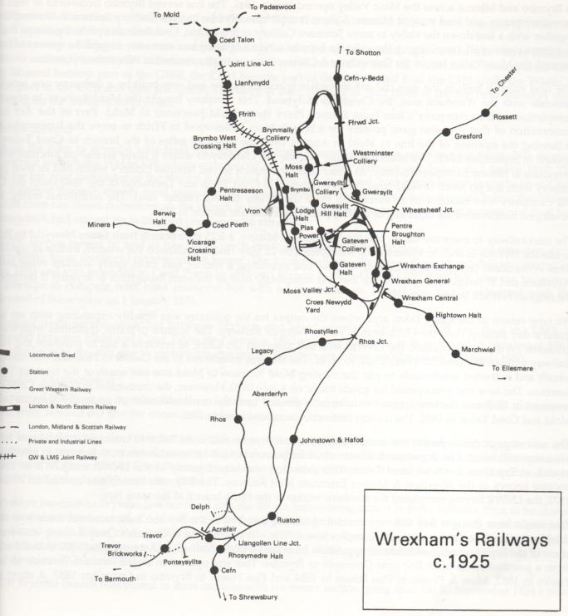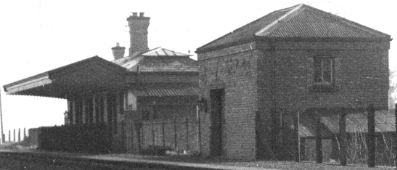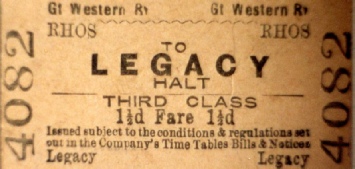
Rhostyllen
A history through pictures

Rhostyllen Station and the Railways
Rhostyllen has had a railway in a loose sort of way since the Great Western Railway (GWR) passed the future site of Bersham Colliery when the Shrewsbury & Chester Railway opened on the 4th November 1846. The colliery wasn’t to open for another 18 years.
The first serious opportunity to have railway facilities came on the 8th October 1892, when an approach was made by the movers and shakers in the village of Rhosllanerchrugog (The Rhos) to the Manchester, Sheffield and Lincolnshire Railways to build a line from Wrexham Central Station to The Rhos. They weren’t interested.
It was felt up in The Rhos that the world was passing them by. Not wishing to be left behind, the GWR was approached again (for the third time) the following year. The population of Rhostyllen at the time would not have justified any railway putting cash into providing a line into the village. The GWR was already taking the colliery’s business – why bother with a few villagers.
The only way that the village was going to benefit from a railway was to ride on the back of anything that The Rhos could come up with. The topography of the area meant that any route to Wrexham would have to pass near to Rhostyllen.
They’d got the bit between their teeth now, and decided to build their own railway to Wrexham, taking in Bersham Colliery; no mention of the inhabitants of Rhostyllen. This was to be known as the East Denbighshire Railway (EDR)
It was going to pass Rhostyllen about one-
Thus, a population of several dozen could only ever ride on the coattails of the Rhos’s population of ten thousand plus……expected to double within fifteen years.
Then, it was to have gone on into the wilderness that was between Laurel Grove and Plas Pen-

As usual with large organisations, whilst they hadn’t wanted to run into The Rhos, the moment another contender appeared, they then put up an alternative.
Then, along came the Great Western Railway with a spoiling tactic.…nothing changes! They’d only gone to Brymbo after the W M & C Q Railway got there.
Their route was quite ridiculous, once again ignoring Rhostyllen’s requirements; they’d already got the colliery traffic, which was where the profit was. The line was to re-
Both the GWR and the EDR lied through their teeth. Whilst there was much talk of passenger provision, the prize was to be the freight traffic.
There were three parliamentary enquiries, and the EDR ran out of cash against the bottomless (legal fees) pockets of the GWR, and were turned down on appealing for capital to the Manchester, Sheffield and Lincolnshire Railways. This left the way open for the GWR, who then got approval for a totally different route….nothing changes!
This is where Rhostyllen features. The GWR were going to upgrade their line from Ruabon to Aberderfyn, and extend it to Legacy. The wagon way from Pontcysyllte to The Rhos was upgraded to a railway, and extended to Legacy. Legacy had a tramway to various collieries which went through Llwynenion, Rhos and Wynn Hall to the canal wharf at Pontcysyllte. Thus, the GWR now had two partial by-
To complete the by-
To reduce the gradient the railway needed to keep as high up the River Clywedog valley side as possible. This only left skirting the dwellings of the village of Rhostyllen as the practical solution. Hence Rhostyllen, by default had its station as a result of favourable gradients!


Stress testing on this line was primitive with ….two engines, with a carriage between, containing the officials, being driven at high speed along the line. Over each bridge the engines were brought to a halt, thus bringing great force upon the desired places. Any sign of danger is at once detected by the officials inside the carriage…..notice the GWR’s high command risked their own lives! The Chester Dee Bridge disaster of 1847 was long past.
The line through Rhostyllen opened on the Tuesday 1st October 1901, with the first passenger train leaving The Rhos at eight-
From the North Wales Guardian of Friday the 4th April, 1901:-
"At Rhostyllen, Mr Holding, formerly stationed at Ffrith, is in charge, and the station premises comprise offices, general and ladies waiting rooms, and a small goods warehouse." He's the gentleman on the platform in the 1902 view below. The article above was kindly provided by Peter Prydderch (formerly of The Rhos).
eter Prydderch 2015)



1905 -
1906 -
1905 -
1898 -



1912 Rhostyllen Station Map
1925 -

1949 -


1963 -
So why did the line close?
Looking at the traffic for Rhostyllen, the passenger potential was always small. The 1924 fares issued were only £540 (about £29k in 2015 – just over £100 a day; not a lot!).
By the time the railway opened (01/10/1901) the tramway was running along the main road into the centre of Wrexham (Brook Street). The train left folk at Wrexham General. The EDR’s plan to use Wrexham Central had been a major point in their proposal. The train journey was, of course, quicker, but with a long walk at the other end. Those with the valid documentation, and pure in spirit, could go the other way to The Rhos. Once again, the station was a fair walk from the centre of the village.
The Press reports of the opening referred to the God-
At the opening there were four trains a day, with two extra on Thursdays and Saturdays. Two goods trains a day served the station. Any wagons had to be collected/dropped off on the train going towards the Rhos. The wagons for Wrexham, and onwards, were dropped at Legacy, and picked up on the return trip.
The advent of the electric tram in 1903 reduced the journey times considerably, putting the train at a disadvantage.
Due to falling passenger traffic, railmotors were introduced on the 1st May 1905. This consisted of a carriage with a miniature locomotive at one end, within the coach body.
Worse was to come for the railway. Omnibuses had reached the area by 1912.
The cheaper to operate railmotors were withdrawn from the furthest reaches of the line in March 1915, leaving only the service to The Rhos. This didn’t affect Rhostyllen’s service, but showed the way things were going.
The passenger services were withdrawn from the branch on the 1st January 1931.
The freight facilities consisted of a siding for fifteen wagons, and a goods warehouse on the platform.
The yellow drawing from 1898 (pictured above) shows a complicated track arrangement; it wasn’t built like that, and simpler plan was adopted, as shown on the white plan (1919).
The receipts for 1924 show Parcels (on a passenger train) at £74 (£4k), and Goods (in wagons) £362 (£19k). Very small takings.
There wasn’t a crane, nor a cattle pen. It did have a loading ramp. Thus, there wasn’t much it could handle. Assuming road transport was required from the customer to the station, anything that could not be handled by the lorry driver and the station master had to go to Wrexham. Once the passenger traffic ceased in 1931, the station became mothballed, and unstaffed.
The only likely traffic then would have been domestic coal. This would have involved a local coal merchant unloading the wagons by hand.
During the latter years MANWEB at Legacy was receiving occasional stores by rail, and there was traffic of coal and rock to The Rhos.
The Rhos had Pant Brickworks which produced refractory bricks for lining furnaces. They needed coal, and rock with a high silica, aluminium, and magnesium content. Also there was a brickworks adjacent to Rhos Station. They, similarly used the railway for coal, and outward for bricks. These two producers kept the line open until road transport developments brought about its closure on the 14th October 1963.
The track was lifted soon afterwards. (Peter Prydderch 2015)

1965 -

This was the locomotive that lifted up the tracks of the Rhos Branch line (including the tracks through Rhostyllen) pictured further up the line in Rhos.
The end of the line?
2015 -


2015 -


Further up the Rhos Branch Line
1893 -
1919 -

The ‘Echo’ Bridge (still standing today)
Legacy
Legacy Station was interesting in as much as it could only issue tickets for stations on the branch line, but it was possible to book a ticket to Legacy from London Paddington! There is still a ‘Station House’ in Legacy but no trace of the railway.



19/02/1949 -
This photograph is likely to be from the Forties/Fifties. Behind the house is a signal gantry. It would have had two arms; one for The Rhos Line, and one for the Ponkey Branch. The right arm (as we're looking) is missing, showing that the Ponkey Branch isn't signalled, and must have closed. A siding to MANWEB would have been controlled by a different kind of signal.
Rhos Station
This website is dedicated to the villages of Rhostyllen and Bersham but without the population and influence of Rhos there would have been no railway through Rhostyllen and subsequently no railway station.
A big thank you again to Peter Prydderch for all his photographs and information about the Rhos Branch Line.
Now this really is the end of the line..…..………….
An enthusiasts' tour at Legacy on 18/04/1959 looking towards The Rhos. Notice the signal box has gone, as has the signal gantry. This train would have later travelled through Rhostyllen.

19/02/1949 -

1957 -


Steam train passing by Bersham Colliery Sidings